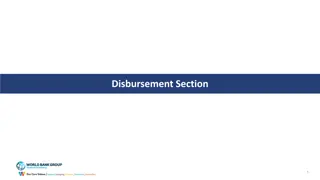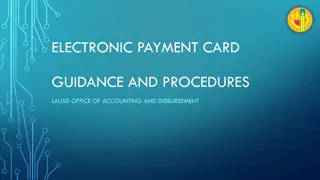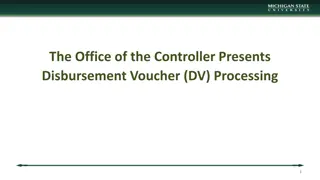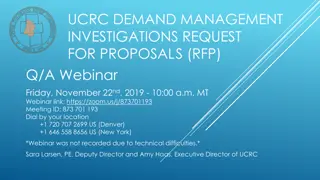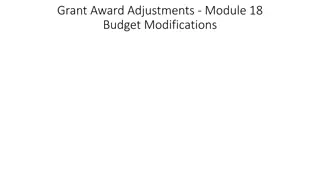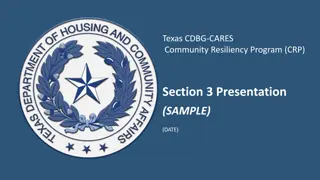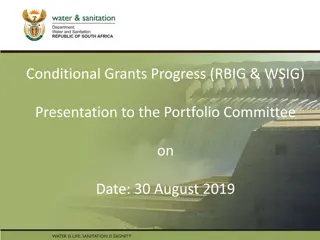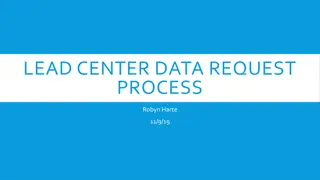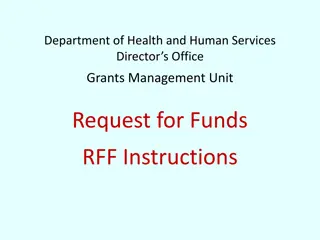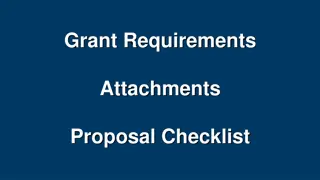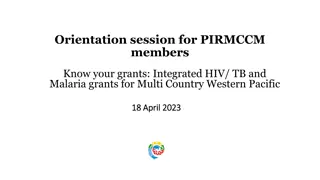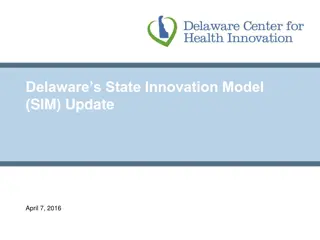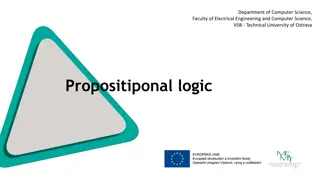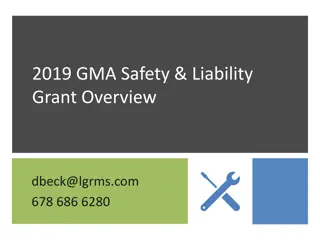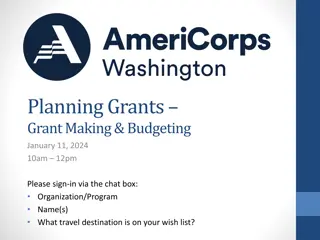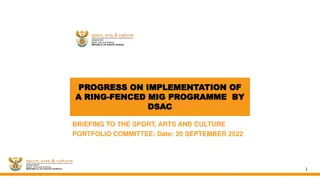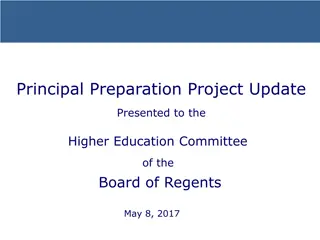Understanding the Role of Progress Update/Disbursement Request Forms in Grant Management
The training slides aim to enhance participant understanding of the significance of Progress Update/Disbursement Request (PU/DR) forms in the Global Fund's performance-based funding system. These forms play a crucial role in managing risks, determining grant ratings, and recommending disbursement amounts, ultimately ensuring efficient fund utilization for life-saving services. The content covers the central role of PU/DR forms, Global Fund reporting requirements, Excel workbook functionality, and the Grant Rating Methodology.
Download Presentation

Please find below an Image/Link to download the presentation.
The content on the website is provided AS IS for your information and personal use only. It may not be sold, licensed, or shared on other websites without obtaining consent from the author. Download presentation by click this link. If you encounter any issues during the download, it is possible that the publisher has removed the file from their server.
E N D
Presentation Transcript
Progress Update/Disbursement Request (PU/DR) forms: Training slide library May 2011
Training Slide Library Objectives To support the roll-out of revised Progress Update/Disbursement Request (PU/DR) forms released in February-March 2011. To provide a comprehensive set of training slides, designed either for self-study, or for selected use by trainers and workshop facilitators, for adaptation to different training needs. The PU/DR form and guidelines in English, French, Spanish and Russian are available on: http://www.theglobalfund.org/documents/lfa/LFA_PUDR_Guidelines_ en.pdf Slide 2
Specific learning points The PU/DR training slides aim to increase participant understanding of: The central role of Progress Update/Disbursement Request (PU/DR) forms, within the Global Fund s performance based funding system, and the grant management cycle. The Global Fund s reporting requirements which are part of the disbursement process, illustrated through working examples. The format and functionality of the Excel workbook used for PU/DR reporting, with emphasis on new sections and fields. Knowledge of the Global Fund Grant Rating Methodology is important for the completion of the PUDR Form. For a summary of the methodology please refer http://www.theglobalfund.org/en/performancebasedfunding/methodol ogy/?lang=en Slide 3
Principal Role of PU/DR forms Performance based funding lies at the heart of the Global Fund s business model. Under this model, disbursement of grant funds is subject to verification and checks of both financial and programmatic information presented by the PR. Every year the Global Fund makes over 1,000 disbursement decisions, based on specific programmatic and financial information, gathered through Progress Update/ Disbursement Request (PU/DR) forms. The PU/DR forms are the most used in the Global Fund. Their principal function is to manage risks, set a grant rating and set a recommended disbursement amount. They are the cornerstone of Performance Based Funding, helping to ensure funds are effectively and efficiently used for delivery of life saving services. Slide 4
PU/DR forms and Grant Management 5. Data used in new Proposal Development: source for CCM and TRP 4. Data used in Grant Renewal cumulative and trend data input to Phase 2/Periodic Reviews 1. Data based on Grant Agreement Performance Framework + Summary Budget templates + Conditions Precedent (CPs) and/or Special Conditions (SPs) 3. Data used for disbursement decision- making grant rating and recommended amount set by LFA-FPM/Country Team PU/DR forms 2. Data used for grant implementation and oversight Management of risks through Management Letters Slide 5
Background of PU/DR revision The old country reporting forms for disbursements (PU/DR) had been in use since early 2006. Modifications to the forms became necessary to address issues and risks identified in the past five years : - - - - - - insufficient guidelines; lack of systematic tracking of progress against Management Actions; inadequate focus on pharmaceutical / health products management; misalignment of PR/LFA reporting forms with DDMFs and the Rating Methodology; limited visibility on usage of funds at SR level; no forms / guidelines in languages other than English. Objective of PU/DR revision: Facilitate country reporting and improve information basis to support grant oversight, risk identification and disbursement decision-making. In 2009/2010, a cross-functional working-group from the Secretariat worked on PU/DR revision. The final forms and guidelines are a product of extensive internal and external consultations with PRs and LFAs, including pilot tests in 6 countries. Slide 6
Structure and contents of revised PU/DR Evaluation of performance Setting disbursement amount 2 6 7 5 1 3 4 Cash Cash Request/ Final DR Overall Performance Procurement and Supply Management Grant Total PR Cash Outflow Reconciliation /DR Programmatic Progress Management Enhanced Financial Reporting (annual) Bank Details (discretio nary use) Annex on SR financials (discretionary use) LFA Findings and Recommendations Excel workbook in two chapters: PR pages + LFA pages . Checklist PR tabs LFA tabs Slide 7
Overview of main modifications Contents: Dedicated section on Procurement and Supply Management (PSM). Extension of Secretariat s grant rating methodology to LFAs. Integration of Enhanced Financial Reporting forms (once a year). New Annex on sub-recipient (SR) financial information, for discretionary use with high-risk grants and/or where SRs receive a substantial proportion of funds (SR financial section is not used in the period when the EFR is due). New Bank Account Details section only to be completed for split disbursements and for cases where bank account details change Comprehensive guidelines for PR/LFAs based on current policies and reporting requirements. Usability: Improved structure. Form and guidelines in English, French, Russian, Spanish. Slide 8
PU/DR reporting timelines and rollout plan Reporting schedule: PR LFA : within 45 days from the end of the reporting period (60 days with EFR) LFA Global Fund: within 10 work days from the receipt of PR form (13 work days with EFR) Phased Rollout: Optional submission of PU/DRs in new format for reporting periods ending before 30 June 2011; Mandatory submission of PU/DRs in new format for the period ending 30th June 2011, and periods. all subsequent The new form and guidelines were distributed to all PRs and LFAs in February- March 2011. Excel version of Grant Rating Tool was also shared with LFA. Slide 9
LFA verification of PR reporting (1) LFA verification of PR reporting needs to be tailored to country and grant risks. Approach to verification is recommended to be reviewed at least annually and agreed upfront between the LFA and the Secretariat. The approach needs to take into consideration: risks identified in the LFA Country/PR Risk Assessment* PR/SR organization, operating characteristics, accounting and control systems; role of SRs and SSRs in program implementation, and PR systems for management and oversight; type of program activities financed by Global Fund, and inherent risks involved; nature of program assets, liabilities and expenditures; knowledge from prior verification work. * The ToR for the Country/PR Risk assessment is on our website under the section Risk Management : http://www.theglobalfund.org/en/lfa/documents/ Slide 10
LFA Verification of PR reporting (2) Typical examples of verification procedures which address identified risks (including fraud): review of PR s internal control procedures; spot-checks of warehouse facilities, service delivery points, bed-net distribution, etc; expenditure review of specific SR financials; verification of a larger sample of invoices; procurement reviews, e.g. tender processes, procurement of vehicles; in-depth verification of high-risk activities e.g. cash payments, per diems at training events. Slide 11
Completing the PU/DR forms, section by section Slide 12
Legend used for inputting tips/ functionality Smiley face indicates fields with drop-down pick-lists (easy selection of specific options) New fields in the revised PU/DR forms colored yellow in slide screen shots Drop- down List New Field PR Pink shaded cells in LFA sheets where LFA has modified PR data LFA Blue shaded cells in the training library indicate fields from which data are automatically exported to the corresponding LFA forms. Grey shaded fields in LFA forms, import data from corresponding PR sheets. Slide 13
Section 1: Programmatic Progress Overview Covers reporting of progress for: Impact/Outcome indicators (sub-section 1A) - important to record for grant renewal decisions. Programmatic Indicators (sub-section 1B) Analysis of data quality and reporting issues (sub-section 1C) summarises issues which may have impacted reporting on programmatic indicators. Only those Impact/Outcome indicators should be listed that are (1) due for reporting and (2) reporting on which is overdue from the previous periods. In contrast, all Programmatic indicators should be listed. Data on baselines and targets for all indicators should be taken from the latest approved Performance Framework. Includes actual results, updates on data collection methods, and comments on variance between intended targets and results. Slide 14
PR_Programmatic Progress_1A (Impact/Outcome) Inputting tips i.e. quarter, semester, annual, other The PU number is based on cumulative PU/DR history, and should be sequential. May not correspond to period numbers in Performance Framework. PROGRESS UPDATE Progress Update - Reporting Period: Progress Update - Period Covered: DISBURSEMENT REQUEST Disbursement Request - Disbursement Period: Disbursement Request - Period Covered: Cycle: Number: Beginning Date: End Date: This should be PU number + 1 Cycle: Number: Beginning Date: End Date: This information is based on the latest performance framework (PF). These header fields export data automatically to subsequent sheets A. Impact / Outcome Indicators Baseline (if applicable) Value Year Comments on results on Impact/Outcome indicators and data sources, and any other comments Report Due Date Data Source of Results Impact / Outcome Year of Target Intended Target Actual Result Indicator Description Select Values input by the PR will export to LFA sheet. Any LFA verified changes will turn relevant cell/s in the LFA sheet salmon pink - - - - - - Select - - - - - - Select - - - - - - Select - - - - - - Slide 15
PR_Programmatic Progress_1B (Programmatic) Inputting tips B. Programmatic Indicators Baseline Targets cumulative ? Intended Target to date Actual Result to date % Reasons for programmatic deviation Objve No. Indicator No. Top 10 ? Indicator Description Tied To achievement ValueYear Is not calculated automatically. Formula to be entered by PR/LFA depending on the indicator value type (numeric vs. Numerator/Denominator/%) these values should correspond to values in the Performance Framework X % This may be re- calculated in the LFA sheet, based on verified results Slide 16
Section 1: Programmatic Progress Important Impact / Outcome Indicators PR should provide explanation in cases of delays in reporting or when there are changes to the data source of results from the originally anticipated data source. The scope of LFA comments on Impact/Outcome indicators is limited to assessing status of reporting on baselines and results (e.g. whether or not a behavioral survey has been conducted) and verifying data source. Programmatic Indicators % achievement of Programmatic indicators plays an important role in disbursement decision-making. It is very important to explain well reasons for under- performance and outline the corrective actions. Significant overperformance needs to be explained as well and, if applicable, rationale for continuation of activities included. The LFA should comment on reasons for under-/over- perfomance and corrective actions. Unlike the scope of verification on Impact/Outcome indicators, LFAs are expected to conduct a thorough assessment of achievement of Programmatic indicators. For further detail, refer to PU/DR guidelines Section 1. Slide 17
Section 2: Grant Management Overview Contains PR s comments and LFA s verification on: 2A fulfillment of CPs and/or special conditions under the grant agreement or subsequent implementation letters; 2B progress on implementation of outstanding management actions from previous disbursements; 2C annual grant reporting requirements. Such as Enhanced Financial Reporting (EFR) and PR Audit reporting. Important: PU/DR reporting on CPs and SCs should cover the conditions that are due for fulfilment or outstanding from previous periods and not all conditions. Slide 18
Section 2: Grant Management Inputting tips The PR and LFA should include the precise number of the CP as per the grant agreement/ Implementation letter, and for management actions reference the date and # of GF management letter/s. For unfulfilled management actions or conditions, reasons should be clearly explained, and timelines given for expected completion. For further detail, refer to PU/DR guidelines Section 2. Points for specific attention of PR, LFA and Secretariat (excerpts from the guidelines) If a CP / special condition that was previously fulfilled is reopened due to new circumstances, and the issue addressed by this condition is considered critical, the issue should be disclosed in the LFA Findings and Recommendations Section. At the discretion of the FPM, the issue may be followed up through the management actions assigned by the Global Fund to PR. Some special conditions may apply to more than one period of grant implementation (e.g. condition on counterpart financing). Their fulfilment during one period does not automatically imply fulfilment in subsequent periods. The LFA will verify that the status of such conditions is reported by the PR during each period concerned. Slide 19
Section 3A: Total PR Cash Outflow Overview Update on PR s actual expenditure against budget, for the period covered by the progress update, and cumulatively from beginning of grant. Financial data disaggregated by: PR s total expenditures; disbursements to sub-recipients (but not SR expenditures!); medicines and pharmaceutical products; health products and health equipment. Explanations of variances between actual expenditure against budget. Explanations of variances in each PU/DR and reconciliation vs. EFR data, on an annual basis, are crucial in disbursement decision-making. The PR should provide a cash flow statement, the Statement of Sources and Uses of Funds (SSUF), along with the PU/DR. The SSUF should reconcile with figures reported in this section, and section 5A_Cash Reconciliation. Slide 20
Section 3A: Total PR Cash Outflow Important Actual expenditures should be reported on a cash basis i.e. based on timing of cash inflow/outflow, regardless of when goods or services are received/delivered. Total Pharmaceutical and Health Product expenditure should be based on payments to suppliers both at the PR and SR levels, including any direct payments made by the GF on behalf of the PR (incl. VPP) Expenditures are those incurred during the current reporting period and cumulatively since the beginning of the program. Special cases: SSF grants: PR should report any remaining expenditures related to liabilities assumed by the constituent grants and which has not been not reported in the last PU/DR of the constituent grant. Cumulation of budgets and expenditures should start from zero from the SSF start date. RCC grants: PR should not cumulate previously reported Phase 1 and Phase 2 financial information but report from the beginning of RCC. Eligible expenditures include those incurred during the grant term, in line with the grant agreement, approved budget, procurement and supply management (PSM) plan, M&E plan, and grant closure plan, or as otherwise agreed in writing by the Global Fund. For further detail, refer to PU/DR guidelines Section 3A. Slide 21
PR_Total PR Cash Outflow_3A PR Inputting tips Actual Cash Outflow for Reporting Period Cumulative Budget through period of Progress Update Cumulative Actual Cash Outflow through period of Progress Update Please select currency used under tab PR_Programmatic Progress _1A Budget for Reporting Period Reason for Variance Variance Variance Reason for Variance 1. Total PR cash outflow vs. budget 0 0 0 0 0 0 Cumulative amounts should reflect amounts from the beginning of the program, or RCC, or the beginning of the current implementation period for consolidated grants 1a. PR's total expenditures 0 0 1b. Disbursements to sub- recipients approved budget amount, as per Grant Agreement or Implementation Letter Should correspond to the latest 0 0 Actual Cash Outflow for Reporting Period Cumulative Budget through period of Progress Update Cumulative Actual Cash Outflow through period of Progress Update Budget for Reporting Period* Reason for Variance Variance Variance Reason for Variance 2. Total pharmaceutical & health product expenditures vs. budget 0 0 0 0 0 0 0 fields in grey are automatically calculated based on inputs rows 1a. 1b. 2a. and 2b 2a. Medicines and pharmaceutical products Based on payments to suppliers. Include any direct payments made by the GF to suppliers on behalf of the PR (including Voluntary Pooled Procurement - VPP) 0 0 2b. Health products and health equipment 0 0 Slide 22
Section 3B: EFR + Annex on SR Financials Overview The EFR (completed annually): is integrated into PU/DR forms to encourage the use of annual expenditure data (with breakdown by categories) in disbursement decision-making. now also includes a breakdown of PR disbursements to each SR (Part E). Data collected through the EFR enables linking financial and programmatic performance, and tracks SR spending against budgets. Annex on SR financials: Provides summary of budgets, disbursements and expenditures by SR and reasons for significant variances and LFA comments on PR's overall verification efforts relating to SRs. PR should complete this Annex only upon the Secretariat s request. Use of this Annex is at the discretion of the FPM/Country Team and is recommended for high-risk grants, or grants where SRs receive a substantial proportion of funding. Slide 23
Section 3B: Enhanced Financial Reporting Inputting Tips PR/LFA should remove the disease specific EFR tabs which are irrelevant to the grant undergoing reporting. The EFR review by the LFA is a review of the process, assumptions and supporting documentation used by the PR to complete the EFR, and explanations on variances (same template as before). The LFA should input its review of the EFR form, under tab LFA_EFR Review_3B. For detailed guidance on completing the EFR form/template, please see: http://www.theglobalfund.org/documents/lfa/ VerificationOfImplementation/GuidelinesForCom pletingTheEFR.pdf Slide 24
PR_Total PR Cash Outflow_3A Values in Total PR Cash Outflow, to be consistent with EFR tab Actual Cash Outflow for Reporting Period Cumulative Budget through period of Progress Update Cumulative Actual Cash Outflow through period of Progress Update Please select currency used under tab PR_Programmatic Progress _1A Budget for Reporting Period Must be equal to total cumulative budget in table A in EFR form Reason for Variance Variance Variance Reason for Variance 1. Total PR cash outflow vs. budget 0 0 0 0 0 0 Must be equal to total cumulative disbursements in table E in EFR form Is not expected to match with Cash outflow (section 3A) as the latter shows disbursements to SRs, but not SR expenditure. 1a. PR's total expenditures 0 0 1b. Disbursements to sub- recipients 0 0 Actual Cash Outflow for Reporting Period Cumulative Budget through period of Progress Update Cumulative Actual Cash Outflow through period of Progress Update Budget for Reporting Period* Reason for Variance Variance Variance Reason for Variance 2. Total pharmaceutical & health product expenditures vs. budget Must be equal to cumulative budget and expenditure respectively, for Medicines and Pharmaceutical products in table A in EFR form 0 0 0 0 0 0 2a. Medicines and pharmaceutical products 0 0 2b. Health products and health equipment 0 0 Must be equal to cumulative budget and expenditure respectively, for Health Products and health equipment in table A in EFR form Slide 25
New: Annex - SR Financials Annex to PU/DR - Sub-recipient financial information - FOR DISCRETIONARY COMPLETION, UPON THE SECRETARIAT'S REQUEST Has the Secretariat requested the PR to complete this Annex for this reporting period? Grant number: 0 Number: End Date: Select 0-Jan-1900 0 0-Jan-1900 Progress Update - Reporting Period: Progress Update - Period Covered: Progress Update - Number: Currency: Cycle: Beginning Date: 0 Variance between Latest Cumulative Expenditure Reported and Cumulative Budget Cumulative Budget through period of this Progress Update* Cumulative Actual Expenditure through period covered by this Progress Update Cash balance at the end of the period covered by this Progress Update Date of Most Recent Disbursement to SR PR's explanation of variance (1) between cumulative budget and cumulative expenditure and (2) between cumulative disbursement and cumulative expenditure (mandatory for amounts above $50,000 or equivalent and with more than 10% variance) Budget for Reporting Period* Cumulative Disbursed through period of this Progress Update* Disbursed during Reporting Period* Name of Entity - - - - - - - - - - - - - - - - - - - - - - - - - - - - - - Date and amount of the latest disbursement to Sub-recipients Cumulative budgets, expenditures and disbursements by SR through the end of the reporting period Explanation of significant variances (1) between cumulative budgets and expenditures and (2) between cumulative disbursements and cumulative expenditures. Cash balance through the reporting period. When the number of SRs is significant (over 10), SRs with smaller budgets (less than 50,000 USD or its equivalent) do not have to be reported separately but can be grouped together as other SRs . Slide 26
Section 4: Procurement and Supply Management Overview This section covers verified information on products actually received by the PR (during the reporting period and cumulatively) vs. value as stated by the PR in the Global Fund s online Price and Quality Reporting (PQR) system. Update of information held in the PQR system, by the PR, is a pre-requisite for any disbursement decision. The PR is ultimately responsible for the accuracy and completeness of data entered. This section also includes a brief update on risks of stock-outs at central level of the grant, and challenges and other issues related to PSM of pharmaceuticals and health products. The LFA must systematically verify completeness of cumulative amounts entered by the PR in the PQR based on products received since January 2011 and comment on variances found between the values of actual receipts, against those reported by the PR in the PQR For further detail, refer to PU/DR guidelines Section 4. Slide 27
Price and Quality Reporting (PQR) Overview The PQR tool is a web-based system, used by the Global Fund to collect transaction level procurement information. The pharmaceuticals and health products to be reported in the PQR include: pharmaceuticals: antiretrovirals (ARVs), antimalarial and anti-TB medicines; health products: insecticide-treated nets (ITNs), long-lasting insecticidal nets (LLINs), condoms and rapid diagnostic tests. The PQR is not an accounting tool. What the PR actually pays for during a given period (reported in Section 3 of the PU/DR), may not correspond to consignments received during the same period (reported in the PQR). The LFA verifies significant differences, backed with supporting documentation. If data entered are based on a cost estimate, or pro forma invoice and the final invoice differs significantly from the data entered originally i.e. over 5% difference in unit costs, the PR should update data in PQR based on the final invoice. For guidance on using the on-line Price and Quality Reporting (PQR) tool: http://www.theglobalfund.org/en/procurement/pqr/ Slide 28
Section 4: Procurement and Supply Management LFA inputting tips The LFA should make sure the PR has fully completed the PQR by going through all consignment documents, noting any invoices not included, verifying unit prices given, and explaining major variances in values. In grants with a major procurement component, and in cases where major risks are present, the LFA should describe the risks in the Findings and Recommendations section, and make actionable recommendations to improve forecasting and procurement. Data on value of products received (from January 2011 onwards) required to complete the LFA table, can be found in: original invoices/shipping documents for goods received, supplied by the PR. the PQR system itself (once verified), through creation of on-line reports covering a specified period. Slide 29
LFA_Procurement Info_4 Inputting tips PR's response LFA's response 1a. Has the PR updated the Price Quality Reporting (PQR) with the required information YES, NO or N/A 1b. Value of Pharmaceuticals and Health Products in the PQR (6 categories only) LFA selects currency based on currency used in majority of invoices Reporting Currency Value of products entered by the PR and verified as correct by the LFA in the PQR during reporting period Cumulative value of products verified as correct by the LFA in the PQR since Jan 2011 Value of products received during reporting period Cumulative value of products received since Jan 2011 PQR Product Categories Reason for Variance Variance Variance Reason for Variance LFA to verify what was actually received based on invoices/ shipping documents Data in columns shaded red taken are obtained from on-line PQR system . Left empty if no products received during current reporting period Slide 30
LFA Findings and Recommendations Overview This section documents issues and recommendations in five key functional/management areas: 1. program management (including management of SRs); 2. financial management and systems; 3. monitoring and evaluation; 4. pharmaceutical and health product management; 5. other management issues, such as PR capacity to generate quality reports. LFA should include important issues identified in each functional area and an analysis of their immediate or anticipated adverse impact on program implementation. (ref. Step 2 of Grant Rating Methodology, PU/DR guidelines Annex 2). An issue is classified as important if it impacts or is likely to impact program implementation and results. The FPM/Country Team will carefully consider, and comment on LFA recommendations in the final column of this form. Instead of repeating detailed information documented in other sections (especially that provided in LFA_Grant Management_2), it is acceptable to summarise issues and cross-reference detailed information in other sections. For further detail, refer to PU/DR guidelines Section LFA-specific Section: LFA Findings and Recommendations. Slide 31
LFA_Findings&Recommendations Inputting tips FPM Comments (to be completed upon receipt of the LFA- verified form) Description of Identified Issues (in order of importance) LFA Recommendations (in order of importance) Functional Areas Recommendations should be relevant, specific and actionable by the PR within a reasonable timeframe. Drop-down pick-list reflects five functional areas, as per previous slide. Pharmaceutical & health product management In grants with a major procurement component, absence of tracking systems for pharmaceuticals and health products should be identified as an important management issue Slide 32
Section 5A: Cash reconciliation Overview Provides information on changes in PR s cash position based on: cash disbursed to PR, or payments made to third parties by Global Fund on PR s behalf; PR expenditures and disbursements to SRs; other income received and net exchange rate gains or losses during the reporting period. Cash balances should cover all grant funds held by PR, or on behalf of PR, in all bank accounts owned and/or used by the PR, regardless of the currency denomination and physical bank location, including any grant funds held with fiduciary agents. The PR must also submit a Statement of Sources and Uses of Funds (SSUFs), linked to Sections 3 and 5. For further detail, refer to PU/DR guidelines Section 5A Slide 33
LFA_Cash Reconciliation_5A Inputting tips A. LFA-VERIFIED CASH RECONCILIATION FOR PERIOD COVERED BY PROGRESS UPDATE PR- LFA-verified amounts LFA Comments (if amounts are different from those reported by the PR) Add: reported amounts 1. Cash Balance: Beginning of period covered by Progress Update Corresponds to actual amount disbursed by the GF. Any associated bank fees are NOT deducted at this stage. If GF disbursement is received after the end date of reporting period, enter this in Section 5B line 5 as cash in transit 2. Cash received by the PR from the Global Fund 3. Cash disbursed to third parties by the Global Fund on behalf of the PR 4. Interest received on bank account 5. Revenue from income-generating activities 6. Other income, if applicable (e.g. income from disposal of fixed assets, tax refunds) US$ 52,793 is not the PR's Less: 0 Gains shown with minus sign, losses shown with plus. It is recommended funds be held in grant currency up to point of utilization, where local currency is devaluing. 7. Total PR cash outflow 460,371 8. Net exchange rate gains/losses 9. Reconciliation adjustments usually exceptional, such as corrections for past periods. 10. Cash Balance: Slide 34
Section 5B: Disbursement Request Overview The disbursement request is based on forecasted expenditure for the period immediately following the progress update ( + extra cash buffer period) and funds available from previous disbursements. Forecasted expenditures should be prepared taking into account: Program s absorption capacity, Changes in the workplan, Changes of unit costs, Cash balance at SR level, Financial commitments, Macro-economic factors (e.g. exchange rate, inflation rate) Significant variances between the initial budget and forecasted expenditure should be explained in light of the factors above and other factors, as applicable. The PR s disbursement request is automatically adjusted taking into account the PR s cash balance and cash in transit . Important: Additional buffer can be requested by the PR if the next PU/DR report is due to include an EFR, or Annex on SR financials, or any other GF requirement which cannot be delivered within 45 days. An agreement in principal for requesting this buffer should be obtained from the FPM in advance. Additional buffer is not an entitlement. Decision on disbursing the additional buffer will be made upon the PU/DR review. For further detail, refer to PU/DR guidelines Section 5B. Slide 35
LFA_Disbursement Recommend_5B Inputting tips B. LFA-RECOMMENDED DISBURSEMENT AMOUNT AND EXPLANATIONS Forecasted amount (reported by Approved budget amount (reported by PR): LFA-verified approved budget amount: 1-Apr- 2010 end date: 30-Sep- 2010 1. Period beginning date: PR): LFA-adjusted forecasted amount: 649,447 Dates calculated automatically. Normal cash buffer of 3 months. 2a. Cash buffer period PR Total Forecast Forecasted amount (reported by Approved budget amount (reported by PR): Period beginning: end date: If the grant qualifies to request an additional buffer, the PR should select the number of months (between 1 and 3 months) for which the request is made. 1-Oct- 2010 31-Dec- 2010 PR): 2b. Additional Cash buffer LFA Total Forecast LFA-verified approved budget amount: LFA-adjusted forecasted amount: Period beginning: PR's explanation of variance between forecasted amounts and amounts originally budgeted. LFA's explanation of any significant variance between forecasted amounts and amounts as originally budgeted. end date: 31-Dec- 2010 Explanations of major variances in budget vs. forecasted amounts are crucial. Slide 36
Section 6: Overall Performance Overview PR s self-evaluation of grant performance to date is a holistic assessment of grant s performance, ideally a combination of quantitative ratios and qualitative information such as: cumulative burn/execution rate for the grant; cumulative disbursement amounts against targets; programmatic achievement (on all indicators, on Top 10 indicators); qualitative overview, indicating areas of strongest and weakest performance; management issues in different functional areas; any major risks which could compromise the program implementation going forward. PR/LFA comments on planned changes to the program, and external contextual factors beyond control of PR that have impacted or may impact the program performance. LFA s overall evaluation and rating of grant performance should be based on Steps 1-3 of the Global Fund s Grant Rating Methodology and PR s comments. Slide 37
Section 6: Overall Performance A. Overall Evaluation and Rating of Grant Performance (including a summary of how financial performance is linked to programmatic achievements) Any major management issues resulting in downgrade? Indicator rating e.g. A2 YES,NO, N/A Overall Grant Rating e.g. A2 The Indicator rating corresponds with Step 1 of the Grant Rating Methodology, Annex 2. The Overall Grant Rating as per Step 3 of the Grant Rating Methodology (ref. Annex 2 of PUDR guidelines). Critical management issues, based on LFA findings section, are taken into account [here]. B. LFA comments on PR planned changes in the program, if any There should be no difference between the two ratings, unless major management issues were identified by the LFA in Section 2 C. LFA Comments on External Factors Beyond Control of the Principal Recipients that have impacted or may impact program Slide 38
Section 7: PR_Cash Request/ LFA_Disbursement Recommendation Overview Part A consists of the LFA s recommended disbursement amount, and whether it is within the indicative disbursement range, based on the LFA s overall grant rating. If outside the ranges, a rationale for disbursement to be provided. Part B - a check-list of verifications carried out by the LFA. Part C - PR bank details, in case of changes or split disbursements. Part D - a summary of the LFA s verification approach in the current PU/DR review driven by the general approach agreed upfront between the LFA and the Secretariat based on country/grant risks. Slide 39
Indicative Disbursement Ranges The principle of Performance-Based Funding links grant performance (overall grant rating) to funds disbursed (indicative disbursement range). Like the Indicator Rating, the Disbursement Range is indicative. Final disbursement amounts may lie outside the indicative range due to a number of factors identified by the Country Team. INDICATIVE DISBURSEMENT RANGES Cumulative Disbursed Amount (after the disbursement) Overall Grant Rating Exceeding expectations Above 95% of cumulative budget through next reporting period A1 Meeting expectations Between 105-85% of cumulative budget through next reporting period A2 Adequate Between 55-95% of cumulative budget through the reporting period B1 Inadequate but potential demonstrated Between 25-65% of cumulative budget through the reporting period B2 Unacceptable Below 35% of cumulative budget through the reporting period C Slide 40
LFA_Disbursement Recommendation_7 Inputting tips Imported from Section 6 Overall Rating A2 Indicative disbursement ranges by performance rating Performance rating Exceeding expectations Meeting expectations Adequate Inadequate but potential demonstrated Unacceptable This data is input manually based on "Disbursements in detail report (PDF)" at http://www.theglobalfund.org/docum ents/disbursementdetails.pdf Range for cumulative disbursement amount Above 95% of cumulative budget through the next reporting period Between 85-105% of cumulative budget through the next reporting period Between 55-95% of cumulative budget through the next reporting period Imported from PR_Cash Request_7A_B A1 A2 B1 Between 25-65% of cumulative budget through the next reporting period Below 35% of cumulative budget through the next reporting period B2 C Three million, one hundred and fifty thousand, five hundred and twenty USD 1. Cash amount requested by the Principal Recipient from the Global Fund for next disbursement period plus one additional quarter (amount in: please select currency in 'PR_Section 1A') 3,150,520 Imported from LFA tab_5B One million, forty two thousand, nine hundred and thirty four USD State the amount in words 1,044,934 2. LFA disbursement recommendation (amount in: please select currency in 'PR_Section1A') Cumulative budget through the next period of implementation (including the buffer) Cumulative disbursed amount to date (*) Cumulative disbursed after recommended disbursement (including the buffer) Sum of these = Is the recommended disbursement within the range? % range Yes 10,000,000 8,755,066 9,800,000 98% Slide 41
Conclusion Quality of PU/DRs submitted to the Secretariat has a direct impact on the speed of disbursement processing and disbursement amounts. Timeliness of PU/DRs is important for ensuring continuous flow or funds and uninterrupted program implementation. For staff involved in preparation of PU/DR it is very important to read and follow the guidelines. Wherever relevant, please inform SRs in advance of the changes and expectations in terms of reporting. Please communicate proactively any training needs related to reporting requirements to the FPM / PO / Country Team members. Slide 42
PU/DR Frequent errors and omissions Lack of relevant Impact / Outcome indicators. Inconsistencies in the way results are reported vis-a-vis the way targets are set (cumulation type, tied to ). Errors in calculation of performance for results reported as Numerator / Denominator / Percentage e.g. Indicator: Number and % of health facilities submitting completed and timely reports. Target: 90/100 (90%). Correctly reported result - 80/100 (80%). Performance: 80%/90% = 89%. Cible: 90/100 (90%). Incorrectly reported result - 80/90 (89%). Performance: 89%/90% = 99%. Insufficient explanation of causes of weak indicatorperformance, as well as indicators significantly exceeding their targets (is there Value for Money to continue these activities?) Lack of information on corrective actions to improve indicator performance. Inconsistency / lack of links between programmatic and financial information in PU/DR. Weak explanation of variances between expenditures vs. budgeted amounts. Weak justification of significant differences between forecasts vs. budgets. Often, forecasted expenditure is not done based on up-to-date workplans, as it should be, and does not take into account cash balances at the SR level. Insufficient attention given to fulfilling conditions and management actions. Weaknesses in completing Overall Performance. Slide 43
Some completed examples of the form The following handouts are intended as an additional resource for use in workshop settings, and/or self study. They consist of completed examples of selected pages from the PU/DR form. Completed examples can be used to: illustrate appropriate (or inappropriate) completion of specified fields. check for understanding, and highlight learning points. stimulate discussion and elicit additional examples, based on participant s own grant data.
PR_Programmatic Progress_1A Completed example A. Impact / Outcome Indicators Baseline (if applicable) Year of Comments on results on Impact/Outcome indicators and data sources, and any other comments The target set is slightly under achieved. A total of 882 PLWHA out of 939 who initiated therapy between 1/Jan/2008 and 1/Dec/2008 were still alive and under treatment a year later, i.e. as of 31/Dec/2009. Among adults, the percentage stands at 93.88 (875/932); and among children, 100 (7/7). Impact / Outcome Intended Target Report Due Date Actual Result Data Source of Results Indicator Description Target Value Year National Statistics Dirctorte % of adults and children with HIV still alive 12 months after initiation of antiretroviral therapy (extend to 2, 3, 5 years as program matures) Impact 2001 2007 03/31/10 74.00 95.85 93.9 AIDS clinical care database The denominator includes people who initiated therapy in the period and died by the end of 2009. Sources of data are the National Statistics Division at MINSAP and the Ficticia Institute. Slide 45
LFA_Programmatic Progress_1A Completed example A. Impact / Outcome Indicators LFA comments on (a) verified result, (b) source of information used by the PR to report results, including the status of completion of surveys and other methods to measure Impact/Outcome, as applicable, Actual Result (as reported by PR) Intended Target Impact / Outcome Year of Target Report Due Date Data Source of Results Verification Method Verified Result Indicator Description Indicator was calculated and reported following UNGASS Guidelines... We consider the program has reached the target set i.e. 98% of target (calculated as 94% actual against 96% target). These high results are in line with universal ARV access targets for Country X, which moreover reports high rate of adherence for ARV treatment (only 2% abandonment). LFA compared the verified result (94%) against that reported in UNGASS country report for the same year , which was 94,9%. Minor difference due to deaths notified after copy deadline for UNGASS report. Other on site visit to *** Institute, and national surveillance system databases, including the clinical care (HMIS) database in MS Access, called SIDATRAT. Other (type as appropriate) National Statistics Directorate, AIDS clinical care database % of adults and children with HIV still alive 12 months after initiation of antiretroviral therapy (extend to 2, 3, 5 years as program matures) Impact 2007 03/31/10 94 95.85 93.90 Slide 46
PR_Programmatic Progress_1B Completed example B. Programmatic Indicators Reasons for programmatic deviation from intended target and deviations from the related workplan activities Baseline (if applicable) % Intended Target to date Actual Result to date Targets cumulative?Top Objective No. Indicator No. achieve- ment Indicator Description Tied To 10 ? Value Year The target is met. A total of 1,195,172 condoms were supplied from the central storage facility to the City of Cuidana and municipalities in this quarter, totaling 1,424,864. There are 1,244,800 units still to be sold under social marketing, out of 2,669,664 condoms that have been received to date. Out of this total, 245,271 units have been sold. Calculated in this example as actual result reported by PR/intended target x 100 = 98.4% Number of social market condoms distributed in the City of La Cuidana and in 18 surrounding municipalities Y-over RCC term Current grant 3 1 Yes 338,64480 2008 98% 1,447,000 1,424,864 Slide 47
LFA_Programmatic Progress_1B Completed example B. Programmatic Indicators LFA analysis on progress to date and any variance between targets and results, and any other comments Actual Result to date (reported by PR) Targets cumulative ? Intended Target to date (from PF) Verific ation Metho d % Objec No. Indica tor No. Indicator Description Verified Result achieve ment Tied to Top 10 ? The difference between result reported by the PR and verified result is due to condoms distributed using Round 6 grant funds. A total of 665,280 condoms have been adjusted in the results for this RCC grant, as these were 'borrowed' from Round 6. The condoms reported are those distributed from central warehouse to provincial warehouses. Number of social market condoms distributed in the City of La Cuidana and in 18 surrounding municipalties PR On- site Visit Y-over RCC term Yes - Top 10 Current grant 3 1 1,447,000 1,424,864 759,584 52% Slide 48
Section 2: Grant Management Completed example, management actions Global Fund Management Actions PR Comments on Progress of Implementation In process. A local consultant was hired to develop a data collection system for condom-distribution-related expenses. A first report including the diagnosis conducted has already been prepared and is attached to this progress report. The system is expected to become operational at the beginning of the next semester. PR will submit a report on use of revenues from condom sales every six months, not later than 15 May 2010, along with the next progress report. PR data exported to LFA sheet Global Fund Management Actions LFA Review of PR Progress on Global Fund Management Actions There were delays in the selection of the local consultant, who will be responsible for identifying expenditures related to condom transportation, handling and storage, and designing a methodology for verifying these expenses. In addition, as the report on utilization of revenues obtained through social market condom sales will be semestral, reporting should commence next quarter i.e. the end of the first semester during which this system is due to be operational. PR will submit a report on the use of revenues from condom sales every six months, not later than 15 May 2010, along with the next progress report. Slide 49
LFA_Total PR Cash Outflow_3A Completed Example Note: Section on Disbursements to SRs has been excluded in this example LFA- Verified Actual for Reporting Period LFA-Verified Budget for Reporting Period LFA- Verified Cumulative Budget All amounts are in: USD LFA Analysis of Variance LFA-Verified Actual Variance Variance LFA Analysis of Variance 1. Total cash outflow vs. budget 264,195 407,578 -143,383 7,200,000 4,000,000 3,200,000 The underspending vs budget is made up of the following variances: The variance relates to overspending on salaries due to certain HR costs related to current quarter being mistakenly included in the next implementation quarter as part of the approved budget. This mistake has been pointed out to the PR and will be corrected at time of the next implementation letter. However, the mistake does not affect the total amount budgeted for HR costs in this grant as it is merely a shift between periods. HR 100k - underspending due to late hiring for ten positions (net of budget mistake identified in current period) Training (20k) overspending due to higher fuel costs and increase in per-diems as per new government circular 1a. PR's total expenditures 91,128 130,993 3,774,068 3,417,384 -39,865 356,684 M&E 277k underspending due to more efficient organization of supervision and quarterly review meetings Slide 50


